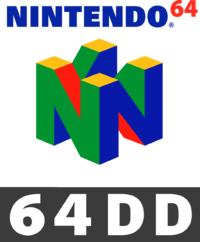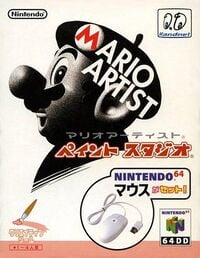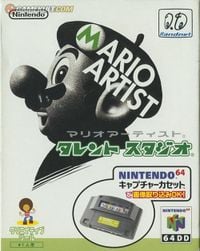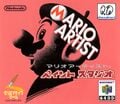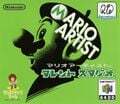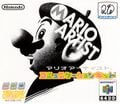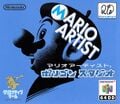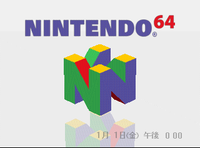Nintendo 64DD: Difference between revisions
m (Text replacement - "''Mario'' " to "''Super Mario'' ") |
mNo edit summary Tag: Mobile edit |
||
| Line 2: | Line 2: | ||
|image=[[File:64DD Console.png|250px]] | |image=[[File:64DD Console.png|250px]] | ||
|generation=Fifth | |generation=Fifth | ||
|release={{release|Japan|December 1, 1999}} {{release|USA|Planned for 2000 ( | |release={{release|Japan|December 1, 1999}} {{release|USA|Planned for 2000 (canceled)}} | ||
|discontinued=February 28, 2001<ref>https://web.archive.org/web/20010413234643/http://www.randnetdd.co.jp</ref> | |discontinued=February 28, 2001<ref>https://web.archive.org/web/20010413234643/http://www.randnetdd.co.jp</ref> | ||
|predecessor=[[Nintendo 64]] | |predecessor=[[Nintendo 64]] | ||
| Line 11: | Line 11: | ||
The '''{{wp|64DD|Nintendo 64DD}}''' (short for "'''64 Dynamic Drive'''")<ref>Schneider, Peer (February 9, 2001). [http://www.ign.com/articles/2001/02/10/everything-about-the-64dd "Everything About the 64DD"]. IGN. Retrieved June 12, 2014.</ref> is a disk drive unit that, like the [[Family Computer Disk System]], attaches to a [[Nintendo 64]] and can play games in a magnetic disk format, with the disks containing their own internal memory written through the N64 instead of the disk itself. There were also several peripherals used for it. | The '''{{wp|64DD|Nintendo 64DD}}''' (short for "'''64 Dynamic Drive'''")<ref>Schneider, Peer (February 9, 2001). [http://www.ign.com/articles/2001/02/10/everything-about-the-64dd "Everything About the 64DD"]. IGN. Retrieved June 12, 2014.</ref> is a disk drive unit that, like the [[Family Computer Disk System]], attaches to a [[Nintendo 64]] and can play games in a magnetic disk format, with the disks containing their own internal memory written through the N64 instead of the disk itself. There were also several peripherals used for it. | ||
While originally planned to release concurrently with the base Nintendo 64, the system was ultimately released in Japan in December 1999, following numerous developmental delays. It was scheduled for release in North America in 2000, but it ended up being a commercial failure both due to its belated Japanese release and due to the way it was sold (mainly through subscription to the Randnet online service, with little to no retail units in stores); consequently, the planned American release was | While originally planned to release concurrently with the base Nintendo 64, the system was ultimately released in Japan in December 1999, following numerous developmental delays. It was scheduled for release in North America in 2000, but it ended up being a commercial failure both due to its belated Japanese release and due to the way it was sold (mainly through subscription to the Randnet online service, with little to no retail units in stores); consequently, the planned American release was canceled, leaving the add-on exclusive to Japan. A remnant of this eventually resurfaced on July 15, 2016, when YouTuber MetalJesusRocks (Jason Lindsey) posted a video showcasing a then-recently-discovered prototype for an American 64DD with an included developer's disk, both of which were verified as legitimate by former [[Nintendo]] of America employee {{wp|Mark DeLoura}}.<ref>https://www.youtube.com/watch?v=b64Bx0WKh7M</ref> On September 2, 2016, MetalJesusRocks did a follow-up on his American 64DD with YouTuber Hard4Games (Tony Visintainer).<ref>https://www.youtube.com/watch?v=Pe-fs1COgr0</ref><ref>https://www.youtube.com/watch?v=FgwM_Zg1U8k</ref> | ||
There were four [[Super Mario (franchise)|''Super Mario'' | There were four games of the [[Super Mario (franchise)|''Super Mario'' franchise]] released on this console, all in the ''[[Mario Artist (series)|Mario Artist]]'' series; there were also several canceled ''Super Mario'' titles. Overall, there were only ten games released on the Nintendo 64DD, although other games planned for the console were released on the original Nintendo 64, the {{wp|PlayStation (console)|Sony PlayStation}}, the {{wp|Dreamcast|Sega Dreamcast}}, and the next-generation [[Nintendo GameCube]] or were canceled altogether. | ||
{{br|left}} | {{br|left}} | ||
| Line 20: | Line 20: | ||
===Mouse=== | ===Mouse=== | ||
[[File:MAPaintStudio2.jpg|thumb|left|''Mario Artist: Paint Studio'' bundle]] | [[File:MAPaintStudio2.jpg|thumb|left|''Mario Artist: Paint Studio'' bundle]] | ||
'''NUS-017''', this replaced analog stick input to allow more precise cursor movements in games that supported it, such as the '' | '''NUS-017''', this replaced analog stick input to allow more precise cursor movements in games that supported it, such as the ''Mario Artist'' series. | ||
===Modem Cartridge=== | ===Modem Cartridge=== | ||
'''NUS-029''', this allowed the Nintendo 64 connect to Randnet. ''Mario Artist: Communication Kit'' made use of this accessory directly. | '''NUS-029''', this allowed the Nintendo 64 connect to Randnet. ''[[Mario Artist: Communication Kit]]'' made use of this accessory directly. | ||
===AV-In Cartridge=== | ===AV-In Cartridge=== | ||
[[File:MATalentStudio2.jpg|thumb|''Mario Artist: Talent Studio'' bundle]] | [[File:MATalentStudio2.jpg|thumb|''Mario Artist: Talent Studio'' bundle]] | ||
'''NUS-028''', this allowed the Nintendo 64 to take in RCA and microphone as input. ''Mario Artist: Talent Studio'' made use of this accessory. | '''NUS-028''', this allowed the Nintendo 64 to take in RCA and microphone as input. ''[[Mario Artist: Talent Studio]]'' made use of this accessory. | ||
{{stub|section=yes}} | {{stub|section=yes}} | ||
{{br}} | {{br}} | ||
==''Super Mario'' games== | ==''Super Mario'' games== | ||
===Released=== | |||
*''[[Mario Artist: Paint Studio]]'' | *''[[Mario Artist: Paint Studio]]'' | ||
*''[[Mario Artist: Talent Studio]]'' | *''[[Mario Artist: Talent Studio]]'' | ||
| Line 65: | Line 65: | ||
|mediafor=Nintendo 64DD | |mediafor=Nintendo 64DD | ||
|file1=Nintendo 64DD start up.oga | |file1=Nintendo 64DD start up.oga | ||
|title1=Boot up sound. | |title1=Boot-up sound. | ||
|description1=A recording, or recreation of an early Nintendo 64DD boot up sound. | |description1=A recording, or recreation of an early Nintendo 64DD boot-up sound. | ||
|length1=0:05 | |length1=0:05 | ||
}} | }} | ||
| Line 72: | Line 72: | ||
==Trivia== | ==Trivia== | ||
[[File:64DD Boot Screen.png|thumb|200px|Boot screen]] | [[File:64DD Boot Screen.png|thumb|200px|Boot screen]] | ||
*If there is no game inserted | *If there is no game inserted in the system, the start-up appears as usual, but [[Mario]] then appears and plays around with the Nintendo 64 logo. The N shape changes when Mario interacts with it.<ref>http://www.youtube.com/watch?v=b6tECCX3B4g</ref> | ||
*''[[Mario Party]]'' originally [[List of Mario Party pre-release and unused content|was supposed]] to be compatible with the Nintendo 64DD, suggesting that ''[[Mario Party 2]]'' was originally [[List of Mario Party 2 pre-release and unused content|supposed to serve as]] an expansion disk to it.<ref>https://www.youtube.com/watch?v=yKu5lABxR2Q</ref> | *''[[Mario Party]]'' originally [[List of Mario Party pre-release and unused content|was supposed]] to be compatible with the Nintendo 64DD, suggesting that ''[[Mario Party 2]]'' was originally [[List of Mario Party 2 pre-release and unused content|supposed to serve as]] an expansion disk to it.<ref>https://www.youtube.com/watch?v=yKu5lABxR2Q</ref> | ||
{{br}} | {{br}} | ||
Revision as of 17:26, August 31, 2023
| Nintendo 64DD | |
|---|---|
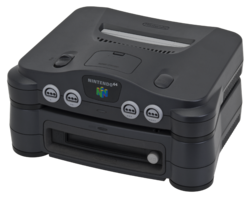
| |
| Generation | Fifth generation |
| Release date | |
| Discontinued | February 28, 2001[1] |
| Predecessor | Nintendo 64 |
| Successor | Nintendo GameCube |
- “The 64DD sat under your N64. Well, not yours — you didn't have a 64DD.”
- —British Official Nintendo Magazine
The Nintendo 64DD (short for "64 Dynamic Drive")[2] is a disk drive unit that, like the Family Computer Disk System, attaches to a Nintendo 64 and can play games in a magnetic disk format, with the disks containing their own internal memory written through the N64 instead of the disk itself. There were also several peripherals used for it.
While originally planned to release concurrently with the base Nintendo 64, the system was ultimately released in Japan in December 1999, following numerous developmental delays. It was scheduled for release in North America in 2000, but it ended up being a commercial failure both due to its belated Japanese release and due to the way it was sold (mainly through subscription to the Randnet online service, with little to no retail units in stores); consequently, the planned American release was canceled, leaving the add-on exclusive to Japan. A remnant of this eventually resurfaced on July 15, 2016, when YouTuber MetalJesusRocks (Jason Lindsey) posted a video showcasing a then-recently-discovered prototype for an American 64DD with an included developer's disk, both of which were verified as legitimate by former Nintendo of America employee Mark DeLoura.[3] On September 2, 2016, MetalJesusRocks did a follow-up on his American 64DD with YouTuber Hard4Games (Tony Visintainer).[4][5]
There were four games of the Super Mario franchise released on this console, all in the Mario Artist series; there were also several canceled Super Mario titles. Overall, there were only ten games released on the Nintendo 64DD, although other games planned for the console were released on the original Nintendo 64, the Sony PlayStation, the Sega Dreamcast, and the next-generation Nintendo GameCube or were canceled altogether.
Accessories
This article's name is conjectural for a part of its content. If an official name is found for the currently unnamed portion of content, it may need to be split into a new article.
Mouse
NUS-017, this replaced analog stick input to allow more precise cursor movements in games that supported it, such as the Mario Artist series.
Modem Cartridge
NUS-029, this allowed the Nintendo 64 connect to Randnet. Mario Artist: Communication Kit made use of this accessory directly.
AV-In Cartridge
NUS-028, this allowed the Nintendo 64 to take in RCA and microphone as input. Mario Artist: Talent Studio made use of this accessory.
 This section is a stub. You can help the Super Mario Wiki by expanding it.
This section is a stub. You can help the Super Mario Wiki by expanding it.
Super Mario games
Released
- Mario Artist: Paint Studio
- Mario Artist: Talent Studio
- Mario Artist: Communication Kit
- Mario Artist: Polygon Studio
Canceled
- Mario Artist: Game Maker
- Mario Artist: Graphical Message Maker
- Mario Artist: Sound Maker
- Mario Artist: Video Jockey Maker
- Mario Party
- Mario Party 2
- Super Mario 64 2
- Super Mario 64 Disk Version[6][7]
- Super Mario RPG 2 (released on the Nintendo 64 as Paper Mario)
- Donkey Kong World, also known as Ultra Donkey Kong and Donkey Kong Universe (reworked into Donkey Kong 64 for the Nintendo 64)
Game gallery
Media
| It has been suggested that audio and/or video file(s) related to this section be uploaded. Reason: Boot tune Please upload all related music, sound effects, voice clips, or any videos for this section. See the help page for information on how to get started. |
| File info 0:05 |
Trivia
- If there is no game inserted in the system, the start-up appears as usual, but Mario then appears and plays around with the Nintendo 64 logo. The N shape changes when Mario interacts with it.[8]
- Mario Party originally was supposed to be compatible with the Nintendo 64DD, suggesting that Mario Party 2 was originally supposed to serve as an expansion disk to it.[9]
References
- ^ https://web.archive.org/web/20010413234643/http://www.randnetdd.co.jp
- ^ Schneider, Peer (February 9, 2001). "Everything About the 64DD". IGN. Retrieved June 12, 2014.
- ^ https://www.youtube.com/watch?v=b64Bx0WKh7M
- ^ https://www.youtube.com/watch?v=Pe-fs1COgr0
- ^ https://www.youtube.com/watch?v=FgwM_Zg1U8k
- ^ Bodamin, Kadu. Super Mario 64 Disk Version existe? Fã mostra em vídeo esta curiosa versão do game rodando em Nintendo 64 japonês Reino do Cogumelo. June 25, 2014.
- ^ http://gamingafterhours.com/2014/06/24/super-mario-64dd-version-discovered-in-japan/
- ^ http://www.youtube.com/watch?v=b6tECCX3B4g
- ^ https://www.youtube.com/watch?v=yKu5lABxR2Q
